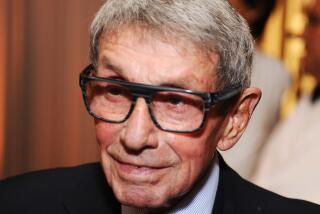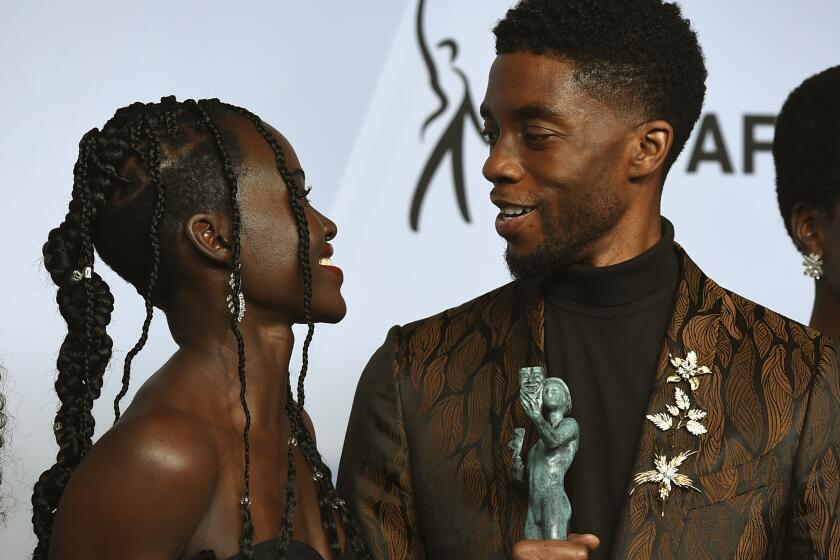Marilyn Monroe: People who knew her recall the real person
Once upon a time, before she was the ultimate screen sex symbol, before she became an icon and source material for generations of writers and artists, Marilyn Monroe was a working actress.
She died 50 years ago this Sunday at the age of 36 from an overdose and in the intervening years the actual person has disappeared behind the myth of “Marilyn Monroe.” A visit to her place of rest at the Westwood Village Memorial Park offers testimony to the power of her memory. The wall of her crypt had to be replaced multiple times because of fans who made a pilgrimage there to caress, embrace and kiss it.
But she was real, and to those who knew her Monroe was a devoted, if troubled, actress who took her craft seriously. In interviews, they remember her as an exceptionally bright and determined woman with a sly sense of humor — a far cry from the sweet but dumb blonds she played in such hits as 1953’s “Gentlemen Prefer Blondes,” 1955’s “The Seven Year Itch” and 1959’s”Some Like It Hot.”She was also someone who could be exasperating to work with — unprofessional with deep insecurities.
PHOTOS: Marilyn Monroe photos by Phil Stern
In the 1956 drama “Bus Stop,” based on William Inge’s Broadway hit, Monroe played Cherie, a down-on-her-luck chanteuse who dreams of going to “Hollywood and Vine.” Don Murray played Beau, an exuberant, naive cowboy who pursues her.
“She was trying to prove she was a serious actress and not just a movie star playing bimbo parts,” said Murray, who earned an Oscar nomination as Beau. “She was trying to prove she was an actress of substance, and in my opinion she certainly did.”
But Murray recalled that Monroe had a difficult time remembering lines, a problem that would plague her through her career. “The joke was she couldn’t make two sentences meet,” said Murray, who noted that she was often two or three hours late on the set. “That was very strange, that lack of discipline,” said Murray.
INTERACTIVE: Marilyn Monroe’s star on the Walk of Fame
“She was a very experienced film actress, but she could forget so many of the mechanical techniques. She would constantly miss her marks so she would be out of focus or out of the light or in a shadow. I think it was a lack of confidence. For somebody who the camera loved, she was still terrified of going before the camera and broke out in a rash all over her body.”
That combination of ambition, skill and fear turns up in other accounts as well. Actress and dancer Mitzi Gaynor performed with Monroe in the 1954 movie musical “There’s No Business Like Show Business,” along with such seasoned musical comedy veterans as Ethel Merman, Dan Dailey and Donald O’Connor. Monroe was still basking in the glow of her sexy “Diamonds Are a Girl’s Best Friend” number from the film “Gentlemen Prefer Blondes.”
“I never saw anybody work so hard,” noted Gaynor. But it wasn’t an easy ride. “She did such a good job and personally, I think she stole the whole damn show. I just think she was thrown into a nest of vipers.”
The cast had years of experience on the stage. Monroe didn’t. “Ethel would say ‘All right, where’s the blond?’ Marilyn was always late on the set if she had to work with Ethel because I think she scared the you-know-what out of her,” Gaynor said.
But Gaynor had another, eerier memory of Monroe. She recalled that the star’s longtime makeup artist Allan “Whitey” Snyder, made an unusual promise to Monroe.
“Whitey told me many years ago that they had a pact that if she died he would make her up so that the paparazzi would at least see a pretty picture of her when they took her out on the gurney,” Gaynor said.
Even though she was a major star, Monroe continued working on her acting skills. In the mid-1950s she studied acting at the Actors Studio in New York. Oscar winner Martin Landau, who currently runs the Actors Studio West with director Mark Rydell, recalls being in class with Monroe at the studio along with some of the leading actors of the day, including Marlon Brando.
“She was taking Lee Strasberg’s private classes and Tuesday and Friday sessions at the studio,” he said in a recent interview. “She was sitting among people like Geraldine Page, Kim Stanley and Patricia Neal. She was kind of docile, quiet and attentive.”
And remarkably gifted. Landau recalled Monroe’s first scene work in front of the class. “It was with Maureen Stapleton, a scene from ‘Anna Christie.’ It was very well-received.” Landau found something very “genuine about her and very needful at times. She had demons. There were mood swings…”
Her sexuality was as visible off-screen as it was on. Another Oscar winner,Louis Gossett Jr.(“An Officer and a Gentleman”), was also in class with her in New York in the 1950s. Monroe was at the height of her beauty and stardom then, and the 20-year-old Gossett was too intimidated to even sit next to her in class.
“So I am at the Actors Studio and there’s Brando and Marty Landau up front,” recalled Gossett. “She had Arthur Miller’s shirt on tied at the waist with some jeans and flip-flops. She says ‘Where’s Lou?’ Everybody starts giggling at me. I think it was a joke [by his classmates]. There is no way I could sit next to her. That’s the effect Marilyn Monroe had on me.”
For all her triumphs, Monroe’s life was filled more than its share of tragedy. Born June 1, 1926, as Norma Jeane Mortenson, Monroe had a Dickensian childhood. Her mother Gladys had bouts with mental illness; her father’s identity was unknown. She was shuttled between foster homes.
She married at 16 and was still a teenager when she began to catch the eye of photographers.
Susan Bernard, author of the new coffee table book “Marilyn: Intimate Exposures,” was just a little girl when she met Monroe. Her father, Bruno Bernard, began taking pictures of the unknown Monroe in 1946 when she was still a curvy, brunet teenager. In the 1955 comedy “The Seven Year Itch,” he captured the classic Monroe pose of her dress floating up in the breeze over the subway grate.
“They were doing the scene with her skirt flying over the grate,” Susan Bernard said. “They were doing the scene over and over again and Billy Wilder was getting exasperated. Suddenly, she saw my dad in the crowd. She ran up to him in front of the whole crew and gave him a big hug and said ‘Remember Bernie, everything started with you.’”
Photographer/writer/director Lawrence Schiller was just 23 when he shot Monroe on the set of 1960’s “Let’s Make Love” and again in 1962 during the production of the ill-fated “Something’s Got to Give,” from which she was fired because of her tardiness and absences.
“There were two Marilyns that I met,” said Schiller, who writes about his experiences with Monroe in his new book, “Marilyn & Me.” “Marilyn in 1960 was like fresh dew on the lawn when you get up in the morning. She wasn’t the stupid dumb blond we saw in the movies. You could really see her humor and wit.”
But in those final months, Schiller felt that Monroe didn’t know “where she was in her life. She was fighting to stay alive. She couldn’t get to work on time. She was taking more of a toll on other people and the studio. She had no perspective. She had no idea what was going on really — no idea at all.”
Are you a fan of iconic stars and films? Like our Classic Hollywood Facebook page to get all The Times coverage.
ALSO:
Marilyn Monroe, with her guard down
PHOTOS: Marilyn’s mystique has legs
INTERACTIVE: Marilyn Monroe on the Hollywood Star Walk
More to Read
Only good movies
Get the Indie Focus newsletter, Mark Olsen's weekly guide to the world of cinema.
You may occasionally receive promotional content from the Los Angeles Times.











